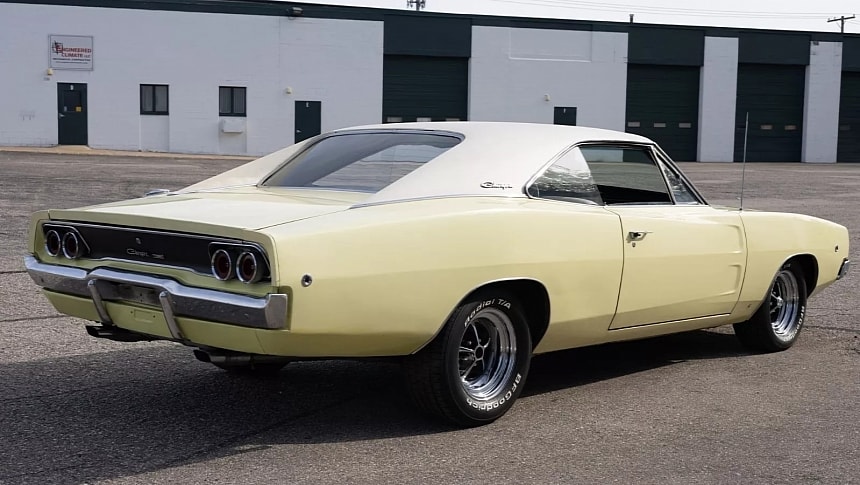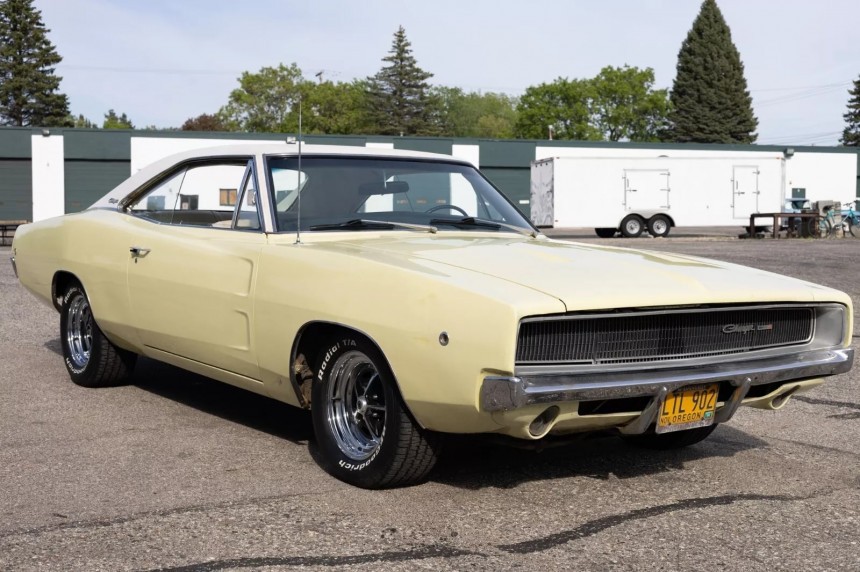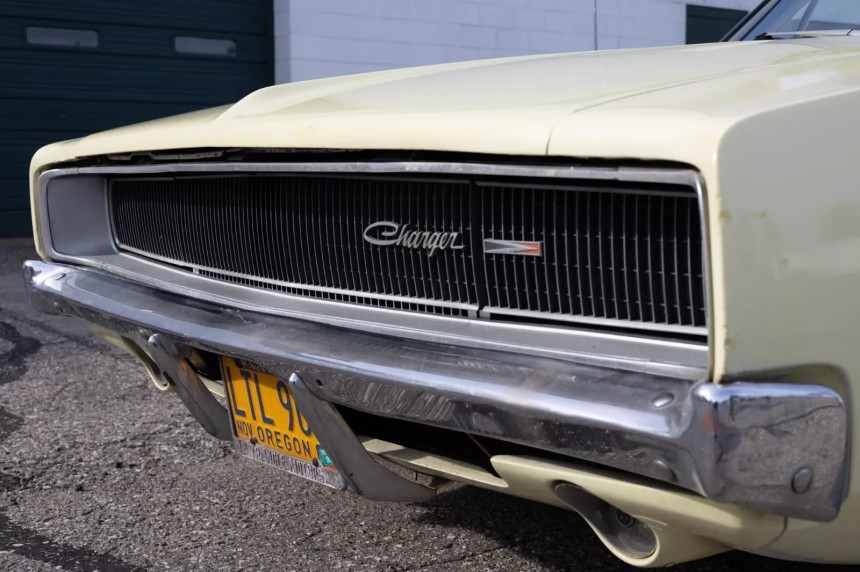Anyone rolling in cash they don’t need, and they’d rather burn into a classic Mopar instead of paying for the kids’ college tuition? Here’s the perfect opportunity to waste 63,000 bucks in one click, and it comes in the shape of a largely original Dodge muscle car. The iconic one – the fever-spreading Dodge Charger of 1968.
This example sports a few tricks, starting with the obvious good overall condition. This is mostly due to it having sat in a barn untouched—and unregistered—since 1990 until the current owner pulled it out, cleaned it up, and put it up for sale. There is good news, and there is not-original-V8 news, so let’s start with the visible details.
This second-generation Charger was born with a 318 and a three-speed automatic Torqueflite (console-controlled), which makes it the low-end V8 choice for the model year. It was the plain-Jane standard equipment in the V8 section of the powertrain options list. However, this car doesn’t have its factory-installed engine under the hood. Instead, it houses a rebuilt 440-4 linked to a replacement A727 gearbox.
The car has been upgraded with power steering and power front disc brakes – but the interior has been left untouched, with the seat cover seams slowly giving in to age and wear. Allegedly, this car is 47,000 miles old (75,640 kilometers), but what’s not specified is how many fall on the 318 cubic-inch (5.2-liter) motor and what has been covered with the bright-painted orange block.
The short video below lets us hear the engine burble for a brief moment, enough to tell that it has no problem starting and running. In fact, the car, despite its age and visible imperfections (cosmetic), could be a great driver from day one. The paint isn’t perfect; there are some minor rust spots, but otherwise, it’s a solid 1968 Charger.
The good news is that the numbers-matching small block and its Torqueflite transmission are included in the sale. The not-so-good news is that the asking price is $62,900 (Or Best Offer, so there’s a chance for a little less than those six grand). According to the seller, this car hasn’t seen the road much in the past 34 years but instead preferred the safety of a barn—it must have been a good region, with low humidity and very loyal cats that kept the rodents at bay.
The Charger sits on replacement—and good-looking—Magnum 500 wheels; they look good, but a date-correct set of wheels would be the least of a potential buyer's worries for a more ‘as-built’ stance. Apart from the parchment White vinyl interior, this old Mopar also boasts its pair of front buckets, the console separating them, and a Rallye instruments panel with a Tic-Toc-Tach.
Auburn Hills, Michigan, is the current address where the car can be seen in person, an endeavor that would be the advised course of action before waving goodbye to 63,000 US dollars. After all, it’s still a 318 car that needs some post-purchase investment. Fixing the interior and whatever is wrong with the heater core shouldn’t break the bank. Still, it’s not exactly Monopoly money either.
The disconnected heater hoses are a sign that something might cost considerable time, effort, and money. Still, the photo gallery is encouraging enough to determine a well-off buyer to see the seller’s asking price. The new fuel tank, mufflers, pipes, and the aforementioned engine and transmission look pretty good, but the original underside isn’t too shabby, either. Final question: price aside, what’s the best take on this car – drive as is, put in the original power team, or restore it to its 1968 original specs?
This second-generation Charger was born with a 318 and a three-speed automatic Torqueflite (console-controlled), which makes it the low-end V8 choice for the model year. It was the plain-Jane standard equipment in the V8 section of the powertrain options list. However, this car doesn’t have its factory-installed engine under the hood. Instead, it houses a rebuilt 440-4 linked to a replacement A727 gearbox.
The car has been upgraded with power steering and power front disc brakes – but the interior has been left untouched, with the seat cover seams slowly giving in to age and wear. Allegedly, this car is 47,000 miles old (75,640 kilometers), but what’s not specified is how many fall on the 318 cubic-inch (5.2-liter) motor and what has been covered with the bright-painted orange block.
The good news is that the numbers-matching small block and its Torqueflite transmission are included in the sale. The not-so-good news is that the asking price is $62,900 (Or Best Offer, so there’s a chance for a little less than those six grand). According to the seller, this car hasn’t seen the road much in the past 34 years but instead preferred the safety of a barn—it must have been a good region, with low humidity and very loyal cats that kept the rodents at bay.
Auburn Hills, Michigan, is the current address where the car can be seen in person, an endeavor that would be the advised course of action before waving goodbye to 63,000 US dollars. After all, it’s still a 318 car that needs some post-purchase investment. Fixing the interior and whatever is wrong with the heater core shouldn’t break the bank. Still, it’s not exactly Monopoly money either.
The disconnected heater hoses are a sign that something might cost considerable time, effort, and money. Still, the photo gallery is encouraging enough to determine a well-off buyer to see the seller’s asking price. The new fuel tank, mufflers, pipes, and the aforementioned engine and transmission look pretty good, but the original underside isn’t too shabby, either. Final question: price aside, what’s the best take on this car – drive as is, put in the original power team, or restore it to its 1968 original specs?





























